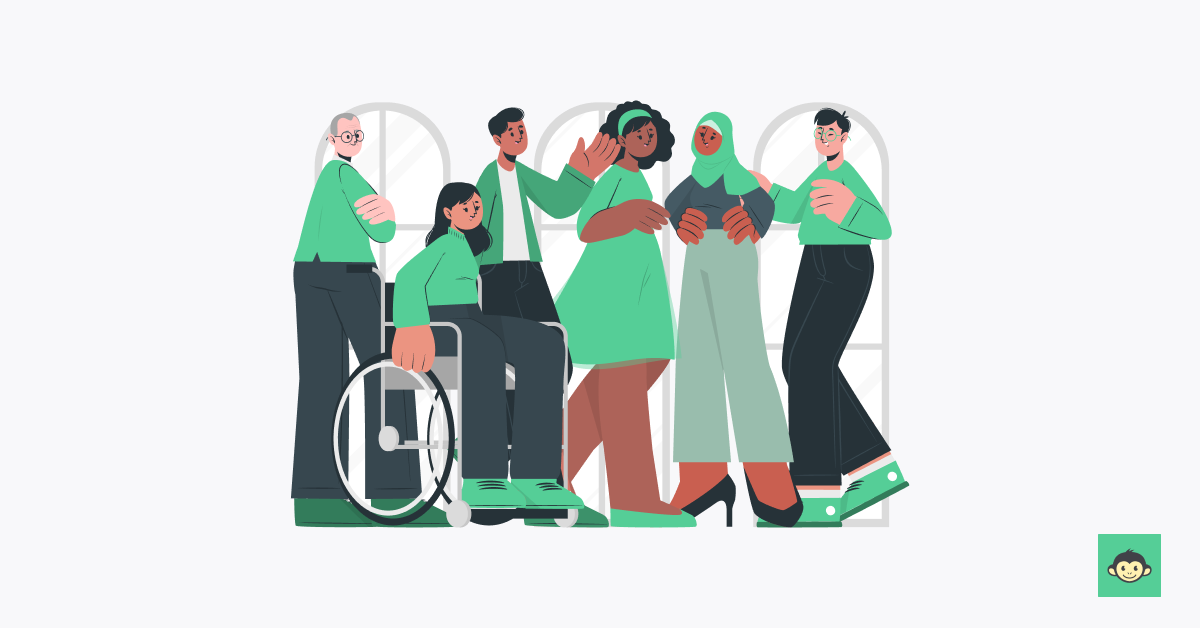Examples and best practices to setup a language-inclusive work culture in 2024

In the modern workplace, fostering an inclusive environment has become integral to organizational success. One of the pivotal elements in achieving this inclusivity is language. Language serves as a powerful tool that can either reinforce barriers or break them down, impacting the way individuals perceive themselves and others.
As we step into the year 2024, the need for language inclusivity in the workplace has gained unprecedented significance.
In this blog, we will explore the concept of inclusive language, understanding its nuances, exploring examples, and delving into the effects it can have on individuals and the overall workplace culture. We'll also provide practical insights and best practices to help organizations establish and maintain a language-inclusive work culture.
Language inclusivity at work: Definition

Language inclusivity at work means using words that don't leave anyone out or make them feel less important. It's about being careful with our words, so we don't hurt or exclude people based on things like gender, sexual orientation, how much money they have, their race, or if they have a disability.
It’s a proactive strategy to cultivate an atmosphere where diversity is celebrated, and each employee's unique identity is acknowledged and respected.
The importance of this practice is underscored by its role in mitigating potential harm caused by language, fostering a sense of belonging, and contributing to a workplace culture where everyone feels heard and valued.
As workplaces evolve, the significance of language inclusivity becomes increasingly vital. It's not solely a matter of conforming to social expectations but a strategic move towards creating an environment that nurtures creativity, collaboration, and mutual understanding.
By embracing language inclusivity, organizations signal their commitment to building a workplace that transcends stereotypes, embraces diversity, and fosters an atmosphere where individuals can thrive both personally and professionally.
In this context, language serves as a powerful tool for shaping a culture that promotes equality, dignity, and a sense of belonging for all.
Is language inclusivity a part of DEI at work?

Language inclusivity is a pivotal component in shaping the culture and ethos of organizations.
The deliberate use of inclusive language, and inclusive terms encompassing considerations such as gender identity, sexual orientation, socioeconomic status, and race and ethnicity, becomes a tangible expression of an organization's commitment to fostering a diverse and equitable work environment.
Fostering respect through inclusive language
At the heart of DEI initiatives lies the quest for respect and acknowledgment of diverse identities.
Language inclusivity serves as a powerful vehicle for achieving this goal by ensuring that communication practices transcend stereotypes and embrace the richness of diverse groups and individual experiences.
By incorporating gender-neutral language, steering clear of gendered terms, and understanding the impact of language on various demographic groups, organizations actively contribute to a workplace culture that values and respects everyone.
Beyond compliance: proactive steps for inclusion
Language inclusivity within DEI is not merely a box to check for compliance; it is a proactive and strategic step. Organizations that prioritize inclusive language are actively contributing to the creation of a workplace where every employee feels valued, heard, and encouraged to bring their authentic selves to work.
This proactive stance aligns with the overarching DEI goals, signaling a commitment to creating an environment that transcends biases, embraces diversity, and fosters a sense of belonging for all.
Inclusive language as a cultural pillar
In essence, language inclusivity becomes a cultural pillar within the framework of DEI. It shapes communication practices that celebrate the diverse tapestry of the workforce, acknowledging the significance of factors such as gender identity, sexual orientation, socioeconomic status, and more.
By prioritizing language inclusivity, organizations take a tangible step towards building an equitable workplace culture that resonates with the principles of diversity, equity, and inclusion.
Why is inclusive language important at work?

Inclusive language holds profound importance in the workplace, serving as a catalyst for fostering a harmonious and equitable environment. Its significance extends beyond mere communication semantics, influencing the very fabric of organizational culture and employee well-being.
Cultivating a sense of belonging:
Inclusive language creates a sense of belonging among employees by acknowledging and respecting their diverse identities.
When individuals feel seen and recognized through the use of language that is considerate of gender identity, sexual orientation, and other aspects of personal identity, it contributes to a workplace culture where everyone feels valued and included.
Enhancing collaboration and innovation:
By adopting inclusive language practices, organizations unlock the potential for enhanced collaboration and innovation. When employees feel heard and respected, they are more likely to contribute their unique perspectives and ideas.
Inclusive language encourages a free flow of communication, breaking down barriers that may hinder the exchange of innovative thoughts and solutions.
Mitigating implicit biases:
Inclusive language serves as a powerful tool in mitigating implicit biases that may be embedded in everyday communication.
By consciously avoiding language that reinforces stereotypes or excludes certain underrepresented groups, organizations can contribute to a more fair and unbiased workplace, promoting equal opportunities and treatment for all.
Boosting employee morale and productivity:
The impact of inclusive language on employee morale and productivity is profound.
When individuals experience a workplace where their identities are respected and reflected in communication, it fosters a positive and supportive atmosphere. This, in turn, has a direct correlation with increased motivation, engagement, and overall productivity.
Aligning with organizational values:
Language serves as a reflection of organizational values. When an organization actively embraces inclusive language, it sends a clear message to employees, clients, and stakeholders that diversity, equity, and inclusion are integral to its core principles.
This alignment contributes to the development of a positive reputation and a strong organizational identity.
In summary, the importance of using inclusive language at work lies in its ability to shape a culture of belonging, collaboration, and innovation while mitigating biases.
It directly influences employee morale and productivity, aligns with organizational values, and contributes to the creation of a workplace where individuals can thrive both personally and professionally.
What are the four rules for inclusive language?

Several guidelines are commonly emphasized to promote inclusive communication in various contexts. Here are four key principles that are often highlighted:
1. Respect diversity:
The first rule for inclusive language underscores the significance of acknowledging and respecting diversity in all its facets. By embracing the uniqueness of each individual, organizations create a culture that values gender identity, sexual orientation, race, ethnicity, socioeconomic status, ability, and more.
The essence lies in using language that goes beyond superficial assumptions or stereotypes, fostering an environment where everyone feels seen, heard, and respected for their distinct experiences and identities.
2. Use gender-neutral language:
The second rule emphasizes the importance of adopting gender-neutral terms and expressions as a fundamental practice for inclusivity. By consciously steering away from gender-specific language, organizations create a linguistic landscape that is welcoming to all genders.
This principle encourages the use of inclusive alternatives, like "they" as a singular pronoun and terms such as "everyone" or "people" in place of gendered language, ensuring that communication is inclusive, affirming, and reflective of the diverse identities within the workplace.
3. Prioritize person-first language:
The third rule places emphasis on prioritizing person-first language, recognizing the individual before their characteristics or conditions. This principle encourages language that humanizes rather than categorizes.
For example, saying "a person with a disability" instead of "a disabled person" reinforces the idea that individuals are not defined solely by their conditions but are unique entities with multifaceted identities.
It aligns with the ethos of acknowledging personhood before any specific attribute, fostering an inclusive and respectful communication environment.
4. Be mindful of cultural sensitivities:
The fourth rule highlights the importance of cultural sensitivity in language use. Organizations are encouraged to be mindful of language that may be sensitive or offensive, acknowledging and respecting cultural differences.
Avoiding terms that perpetuate stereotypes or marginalize certain groups becomes crucial in promoting an inclusive culture.
Continuous learning and staying attuned to evolving language norms are vital aspects of this rule, ensuring that communication remains respectful and considerate of diverse cultural backgrounds.
It's crucial to recognize that these principles serve as general guidelines, providing a foundation for inclusive language practices. The specific rules may vary based on cultural contexts, evolving social norms, and the unique needs of diverse and marginalized communities.
Regularly updating knowledge and remaining open to feedback are essential elements in the ongoing commitment to implementing and refining inclusive language practices.
What are the top 7 negative effects of not practicing language inclusivity at work?

From diminishing morale to heightened attrition risks, the negative effects underscore the imperative of fostering an inclusive language culture for a thriving and resilient organizational environment.
1. Decreased employee morale and engagement:
The absence of language inclusivity significantly influences the morale and engagement levels among employees. When individuals feel overlooked or marginalized due to insensitive language, their commitment and enthusiasm for their work start to wane.
This diminishing morale not only affects individual job satisfaction but also permeates overall team dynamics, impacting collaboration, communication, and the productivity of the entire workforce.
2. Higher rates of employee burnout:
Exclusionary language becomes a precursor to elevated levels of stress and burnout among employees. The impact of feeling unrecognized or disrespected in communication extends beyond professional dissatisfaction, leading to increased feelings of isolation and fatigue.
This, in turn, creates a workplace environment where the mental health and well-being is compromised, contributing to higher rates of burnout that can have long-term implications for both individuals and the organization.
3. Impaired team collaboration and innovation:
Inclusive language is a catalyst for fostering an environment where diverse perspectives are not only acknowledged but valued. The absence of this inclusivity, or implicit bias, however, compromises the collaborative dynamics within teams.
The reluctance to share ideas or speak up due to fear of bias impedes the free flow of creativity and problem-solving. As a result, the innovative potential of the workforce is stifled, hindering the organization's ability to adapt and thrive in a rapidly evolving business landscape.
4. Increased risk of workplace conflicts:
Non-inclusive language serves as a breeding ground for interpersonal conflicts within the workplace. Misunderstandings, microaggressions, and resentment become prevalent, creating a toxic work environment.
Addressing and resolving these conflicts become intricate challenges, leading to a decline in teamwork, cooperation, and overall employee satisfaction. The workplace, instead of being a collaborative space, becomes a battleground for unspoken tensions.
5. Negative impact on recruitment and talent acquisition:
The repercussions of a lack of language inclusivity extend to the organization's external image. Prospective employees, drawn to workplaces that prioritize inclusive communication, may be deterred from joining an organization by plain language that fails to meet these expectations.
The negative impact on the employer brand can hinder the recruitment and talent acquisition processes, making it challenging to attract a diverse pool of skilled individuals.
6. Higher turnover rates and attrition:
Attrition rates surge when employees feel unsupported or undervalued due to exclusionary language. The failure to cultivate an inclusive company culture prompts talented individuals to seek employment elsewhere.
This not only results in higher turnover rates but also incurs substantial costs related to recruitment, onboarding, and training. The organization faces the challenge of retaining top talent, impacting its overall stability and continuity.
7. Legal and reputational risks:
Insensitive language exposes an organization to legal and reputational risks. Language that perpetuates stereotypes or discriminates against certain marginalized groups can lead to negative publicity and legal actions, tarnishing the organization's standing in the industry and among its stakeholders.
The fallout from such risks extends beyond the immediate consequences, impacting the organization's long-term success and sustainability.
In summary, the repercussions of neglecting language inclusivity reach far beyond the surface of communication dynamics. They permeate the organizational fabric, affecting employee well-being, collaboration, and recruitment efforts, and even posing significant legal and reputational threats.
Recognizing the potential increase in attrition rates underscores the urgency and critical importance of fostering an inclusive language culture within the workplace.
8 Best practices to develop and sustain language inclusivity at work in 2024

As we navigate the complexities of the modern workplace in 2024, prioritizing language inclusivity is paramount for fostering an environment where diversity thrives.
In this section, discover eight best practices designed to develop and sustain language inclusivity, ensuring workplaces resonate with respect and embrace the diverse identities of their employees
1. Implement inclusive language guides:
Implementing inclusive language guides is a foundational practice in creating an inclusive workplace. These guides serve as a compass, tailored to the unique dynamics of the organization.
By addressing crucial areas such as gender identity, sexual orientation, and socioeconomic status, these guides provide a comprehensive roadmap for employees, fostering an environment where the richness of language respects and reflects diverse identities.
2. Prioritize continuous education:
Prioritizing continuous education establishes a culture of ongoing learning within the organization. Regular training sessions on language inclusivity become more than a procedural requirement; they become forums for understanding evolving language norms and navigating implicit biases.
This commitment to education ensures that employees remain informed, engaged, and equipped to foster respectful and inclusive language practices.
3. Integrate inclusive language into job descriptions:
Integrating inclusive language into job descriptions transcends mere recruitment practices; it becomes a commitment to diversity and inclusion from the outset.
By avoiding gendered terms and promoting diversity in language, organizations not only attract a more diverse pool of candidates but also set the tone for an inclusive workplace culture that values and celebrates differences.
4. Encourage pronoun inclusivity:
Encouraging pronoun inclusivity goes beyond compliance; it cultivates a workplace where everyone feels seen and respected.
Making it a standard practice for employees to include their pronouns in email signatures and introductions becomes a small yet impactful gesture that contributes to a more inclusive and supportive environment, affirming diverse gender identities.
5. Create an inclusive environment in communication:
Fostering an inclusive communication environment is not just about words; it's about shaping a culture that values each individual's unique identity. Actively incorporating person-first language emphasizes the individual before their characteristics.
This commitment to personhood over labels contributes to a workplace culture that respects, values, and celebrates the diverse identities of its members.
6. Regularly review and update language policies:
Establishing a framework for regular reviews and updates to language policies is a proactive step in adapting to evolving linguistic trends.
Staying attuned to emerging language norms ensures that policies reflect the organization's commitment to inclusivity, preventing language guidelines from becoming outdated.
This dynamic approach ensures that the organization remains at the forefront of linguistic inclusivity.
7. Empower employee resource groups:
Empowering Employee Resource Groups (ERGs) is not just a checkbox for diversity; it's a strategic move to leverage insights for linguistic inclusivity. ERGs focused on various diversity dimensions actively contribute to shaping inclusive language practices.
By providing valuable insights everyday language itself, these groups foster a sense of belonging among their members, ensuring that linguistic inclusivity is driven by the very individuals it aims to empower.
8. Celebrate linguistic and cultural diversity:
Acknowledging and celebrating linguistic, racial identity and cultural diversity within the workplace is more than a symbolic gesture—it's a commitment to embracing the organizational tapestry.
Recognizing and respecting the various ways individuals express themselves becomes a cornerstone of a workplace culture that values diversity.
By embracing the richness of language as a reflection of diverse backgrounds, organizations cultivate an environment where every voice is heard, acknowledged, and celebrated.
Embracing the outlined best practices for language inclusivity not only fortifies organizational cultures with respect and understanding but also positions workplaces as beacons of diversity in 2024.
By implementing these strategies, organizations pave the way for an inclusive linguistic landscape that reflects and celebrates the rich tapestry of their workforce
Role of DEI surveys in voicing language inclusivity issues at work for your employees

In the pursuit of fostering an inclusive workplace, Diversity, Equity, and Inclusion (DEI) surveys emerge as a vital tool for uncovering language inclusivity issues among employees.
These surveys serve as a powerful mechanism to give voice to individuals who may otherwise feel unheard, providing invaluable insights that enable organizations to proactively address linguistic challenges.
Capturing employee experiences:
DEI surveys offer a structured platform for employees to candidly express their experiences with language inclusivity.
By incorporating specific questions related to language use, terminology management, and overall communication dynamics, these surveys create a safe space for individuals to articulate concerns or observations regarding language inclusivity within the organizational context.
Identifying blind spots and unconscious biases:
Through targeted questions about language, DEI surveys act as a mirror reflecting the organization's linguistic landscape.
They help identify potential blind spots and unconscious biases embedded in communication practices, shedding light on areas that may require attention. This self-awareness enables organizations to initiate meaningful changes to foster more inclusive language.
Quantifying perception disparities:
DEI surveys allow quantitative measurement of perception disparities related to language inclusivity. By collecting data on how different demographic groups perceive language use within the workplace, organizations gain valuable insights into potential discrepancies.
This data-driven approach helps pinpoint specific areas that may be contributing to inequitable experiences and guides strategic interventions.
Informing tailored training and development:
The insights derived from DEI surveys inform the development of targeted training and development programs.
Organizations can design initiatives that address specific language inclusivity challenges highlighted by survey responses, ensuring that interventions are tailored to the unique needs and concerns voiced by employees.
Fostering a culture of continuous improvement:
By implementing a feedback loop based on survey results, organizations demonstrate a commitment to ongoing enhancement in language inclusivity.
This iterative process allows for the tracking of progress over time, ensuring that the organization remains responsive to the evolving needs and expectations of its diverse workforce.
Building trust and engagement:
The mere act of conducting DEI surveys focused on language inclusivity sends a powerful message to employees. It demonstrates a commitment to listening and valuing the perspectives of each individual.
As employees see their concerns being acknowledged and addressed, trust is nurtured, leading to increased engagement and a sense of belonging within the workplace.
Aligning strategies with employee expectations:
DEI surveys play a pivotal role in aligning organizational strategies with the expectations of employees regarding language inclusivity.
The data collected enables leadership to prioritize initiatives that resonate with the workforce, ensuring that efforts to enhance language inclusivity directly address the nuanced needs and preferences of a diverse group of individuals.
In essence, DEI surveys stand as a cornerstone in the journey toward a linguistically inclusive workplace.
By providing a structured avenue for employees to voice their experiences, quantifying perceptions, and informing targeted interventions, these surveys empower organizations to not only address existing language inclusivity issues but also to proactively shape a workplace culture that values and respects the diverse linguistic identities within its ranks.
Conclusion
As we navigate the ever-evolving landscape of the modern workplace, the concept of inclusive language emerges as a linchpin for fostering a harmonious and progressive work culture.
Inclusive language extends beyond mere semantics; it is a dynamic force that shapes organizational identity, nurtures diversity and upholds the principles of respect and human dignity.
From dismantling negative stereotypes to embracing the richness of diverse populations, the impact of inclusive language is profound.
In 2024, organizations are presented with a unique opportunity to embed inclusive language into the fabric of their workplaces.
By crafting job descriptions that prioritize diverse populations, respecting preferred pronouns, and recognizing distinct groups, businesses can set the stage for a more inclusive and equitable hiring process.
Addressing sensory disabilities and embracing continual learning initiatives further ensures that every employee, regardless of their background, feels valued and understood.
The effects of inclusive language reverberate through employee engagement, team collaboration, and the very essence of organizational culture.
It becomes a catalyst for positive change, mitigating the risk of negative stereotypes and fostering a sense of belonging among employees.
In this era of heightened awareness, words truly matter, influencing perceptions and contributing to the creation of a workplace where individuals are not defined by labels but celebrated for their unique identities.
To embark on a transformative journey toward a more inclusive workplace culture, incorporate inclusive language!
Culture Monkey offers a suite of tools designed to measure, understand, and enhance your organizational culture. From crafting job descriptions to fostering continual learning and celebrating diverse talents, CultureMonkey empowers organizations to cultivate a workplace that aligns with the values of 2024.
Visit CultureMonkey today and harness the power of data-driven insights to build a workplace culture that reflects the diversity and inclusivity your organization aspires to achieve.



